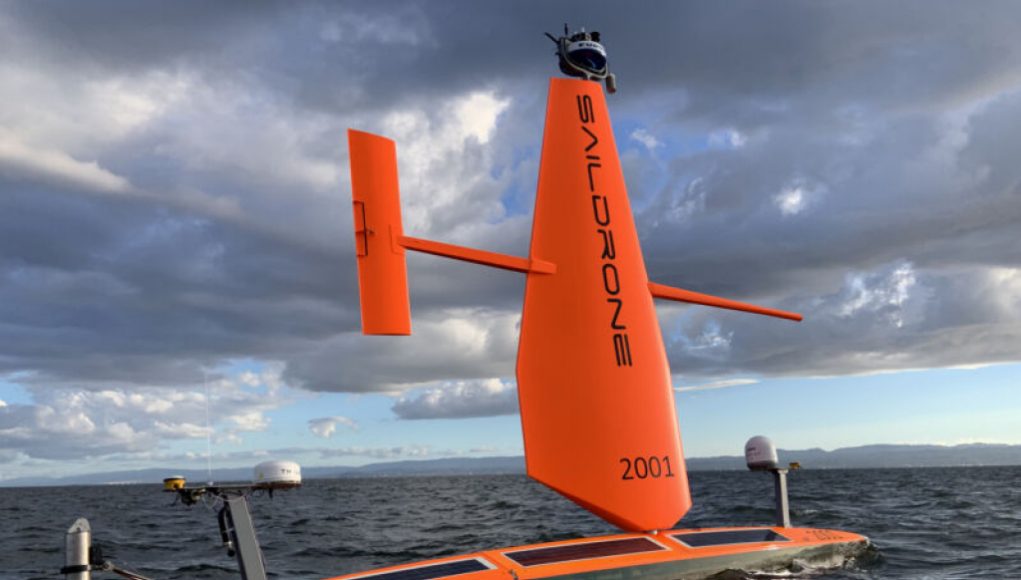The future can be both terrifying and amazing, and science fiction has shown us both sides. But sometimes, the present can be just as incredible. Take the oceans, for example. There’s a technological revolution happening right now that most people don’t even know about. “We’re at the cusp of a proliferation of lots of autonomous vehicles in the ocean,” says Alex De Robertis, a biologist at the Alaska Fisheries Science Center of the National Oceanic and Atmospheric Administration (NOAA). “Things that were science fiction not so long ago are kind of routine now.” One of the most exciting developments is the saildrone, a sailboat-like uncrewed surface vehicle (USV) that can travel the oceans on wind and solar power.
Saildrones are commissioned by NOAA and other science teams to serve as mobile meteorological stations, biological monitoring devices, and even ocean floor mappers—all without the need for people on board. They can survive terrifyingly tall waves, hurricane-force winds, and seas studded with ice, and they can stay out for months at a time. “The ocean covers 70 percent of the world, [but] when you think of actual volume, we know so very little about it,” says Noah Lawrence-Slavas, an engineer at NOAA’s Pacific Marine Environmental Laboratory (PMEL). Saildrones could provide some answers.
Saildrone offers its craft in three sizes: the Explorer, the Voyager, and the Surveyor. The Explorer is the little workhorse, a 23-foot-long vehicle propelled by wind that can sail the seas for a year at a time. With sensor packages powered by solar panels, it can monitor meteorology and ocean chemistry, track fish, and/or measure carbon dioxide at the ocean-atmosphere interface. The 33-foot-long Voyager comes equipped with diesel power to supplement wind and solar. It can map the ocean floor to a depth of 300 meters and is used for maritime security. The longest, largest option, the Surveyor, was designed for deep ocean mapping, down to 7,000 meters.
Saildrones are customizable, with the Explorer able to have between 15 and 20 sensors configured into a package for customers. This sort of customization wasn’t always an option. A little over a decade ago, PMEL began to explore ways to replace or supplement ship-based observations, partly because ships are incredibly expensive. In 2014, Saildrone reached out to give a presentation about its concept vehicle’s successful voyage from the San Francisco Bay to Hawaii. Autonomously crossing a substantial amount of ocean piqued PMEL’s interest, but there was still a big gap when it came to utility. To ease the development of saildrone sensors, NOAA entered into a cooperative research and development agreement, or CRADA, with Saildrone in 2014. CRADAs set out project goals, describe agreements on intellectual property, and streamline paperwork.
The oceans are vast and mysterious, but with saildrones, we’re starting to unlock their secrets. Who knows what other amazing technologies are waiting to be discovered?
In a fascinating innovation that promises to revolutionize atmospheric and oceanic research and monitoring, saildrones, the world’s first unmanned surface vehicles (USVs), are being deployed to measure and track conditions in the world’s oceans.
The self-propelled, wind- and solar-powered vessels are set to traverse the world’s seas in pursuit of answers to questions regarding, among other things, global warming, weather patterns, and effects on marine life.
Essentially a combination of a conventional aerial drone and a sailboat, the international firm Saildrone Inc. has developed a fleet of vessels—each equipped with precision-measuring sensors—that collect vast amounts of data while roaming the world’s waterways.
Saildrones are designed to travel long distances autonomously, requiring little maintenance while, at the same time, gathering invaluable measurements and information.
Thanks to their ability to travel across open ocean and into previously inaccessible areas, such as the Arctic and Antarctic, the saildrones will move into regions where scientists have had difficulty performing measurements.
Besides being set loose as gas-powered research vessels, the saildrones’ artificial intelligence capabilities further enable them to aid in marine management and ocean resources surveying.
Saildrone Inc. has begun equipping their USVs with sonar technology, allowing the craft to better produce depth profiles of the world’s oceans and seas.
This sonar will be instrumental in mapped surveys of coastlines and seafloor habitats.
Under the watch of their operators, the saildrones will patrol the world’s waters, gathering data to aid scientists in the continued understanding and appreciation of our planet’s waters.
Although they are still in their early stages, the use of saildrones at a global scale will undoubtedly become a key tool for researchers worldwide.
In the future, these vessels are likely to furthermore be utilized for oil and gas exploration, search and rescue operations, and general surveillance of marine conditions.




















